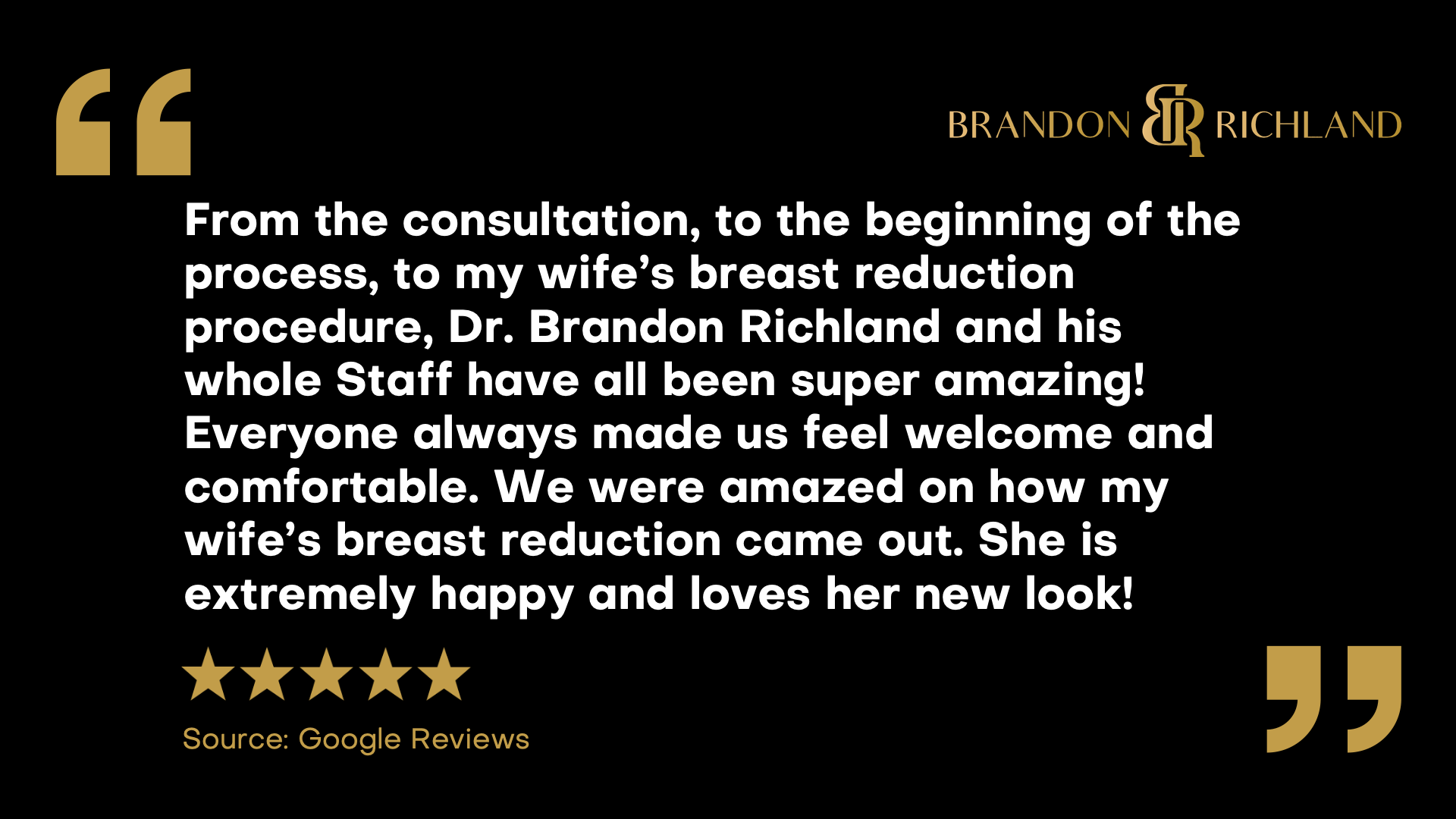Published by Dr. Brandon Richland, MD

“From the consultation, to the beginning of the process, to my wife’s breast reduction procedure, Dr. Brandon Richland and his whole Staff have all been super amazing! Everyone always made us feel welcome and comfortable. We were amazed on how my wife’s breast reduction came out. She is extremely happy and loves her new look!”
Read the full Google Review here.
Breast Reduction Overview
Breast reduction surgery is a procedure designed to alleviate discomfort and enhance the quality of life for individuals with disproportionately large breasts. It involves the removal of excess breast tissue, fat, and skin to achieve a breast size more proportionate to the body.
Definition and Benefits
Breast reduction, also known as reduction mammoplasty, is a surgical operation targeted at reducing the size of large breasts. The procedure entails the removal of excess fat, tissue, and skin from the breasts to alleviate the physical and emotional burden on patients. Benefits of breast reduction include:
- Relief from discomfort: Reduction of back, neck, and shoulder pain that can occur with large breasts.
- Increased mobility: Better ability to participate in physical activities.
- Improved appearance: Proportionate breast size relative to the patient’s body.
- Enhanced self-esteem: Positive impact on self-image and confidence.
Suitability for the Procedure
Suitability for breast reduction is determined on an individual basis. Candidates typically experience health or lifestyle limitations due to the size of their breasts and often report related pains and discomfort. Ideal candidates may have:
- Physical symptoms: Chronic pain in the back, neck, or shoulders, skin irritation under the breast fold, and indentations from bra straps.
- Lifestyle restrictions: Difficulty engaging in exercise or finding well-fitting clothing.
- Emotional impact: A desire to improve self-esteem and reduce the psychological impact of having large breasts.
Patients considering breast reduction should consult with a qualified plastic surgeon to discuss potential outcomes, risks, and the recovery process.
Preparing for Surgery
When a patient is considering breast reduction surgery, certain preparations are necessary for a safe procedure and smooth recovery. These involve both a thorough medical consultation and specific pre-operative guidelines.
Medical Consultation
The medical consultation is a critical step where the surgeon reviews the patient’s medical history, including any previous surgeries or underlying health conditions. During this time, it is essential for the patient to be transparent about their smoking habits, as smoking can significantly affect healing. They should also provide a comprehensive list of medications, vitamins, and supplements they are taking, especially any that might influence blood clotting, like aspirin.
- Medical History: Review any past medical events and conditions.
- Smoking: Discuss smoking habits and cessation.
- Medications: List all current medications and supplements.
Pre-Operative Guidelines
Prior to surgery, the surgeon will provide a list of pre-operative guidelines to help ensure the patient’s safety during the procedure and aid in their recovery. This includes instructions regarding fasting, the use of medications, and arranging for someone to assist post-surgery. Patients are generally advised to avoid medications that can increase bleeding, such as aspirin, for at least a week before surgery. Additionally, they should discuss the implications of anesthesia and how it may interact with current medications.
Patients may also need to contact their insurance provider to discuss coverage details and any necessary pre-authorizations. It’s important that they understand the financial aspect and any costs involved regarding the surgery and aftercare.
- Fasting: Abstain from eating or drinking for a specified time before surgery.
- Medications: Cease taking certain medications as instructed.
- Insurance: Confirm details and authorizations with the insurer.
- Anesthesia: Understand the risks and interactions with other medications.
- Post-Operative Care: Ensure arrangements for post-surgery assistance are made.
The Surgical Process
The surgical process of breast reduction primarily involves the removal of excess breast tissue, fat, and skin to achieve a breast size proportionate to the patient’s body. The goal is to alleviate discomfort while ensuring a natural-looking result.
Reduction Techniques
A variety of reduction techniques exist, tailored to the patient’s anatomy and desired outcome. Common methods include:
- Liposuction: Primarily used when the need to remove fat from the breast is greater than the need to remove excess skin.
- Vertical or “Lollipop” Incision: This technique involves an incision around the areola and vertically down to the breast crease, suitable for moderate reductions.
- Inverted T or “Anchor” Incision: The most traditional method, involving three incisions: around the areola, vertically down from the areola to the breast crease, and along the crease underneath the breast. It’s typically used for significant reductions.
During the Operation
During the operation, the patient is placed under general anesthesia within a hospital or medical facility. The surgeon will:
- Make the pre-marked incisions.
- Remove excess breast tissue, fat, and skin.
- Reshape the remaining tissue and reposition the nipple and areola if necessary.
- Close the incisions with stitches, sometimes using a drainage tube to remove excess fluid.
Post-Surgical Care
After breast reduction surgery, immediate post-operative care is critical for recovery. The patient may experience pain, discomfort, and swelling which can be managed with pain medication and ice packs. The patient is typically placed in a surgical bra right after the operation, which provides support and helps with healing. Bandages or dressings will cover the incision sites, and a drainage tube might be in place.
In the weeks following surgery, patients are advised to:
- Avoid heavy lifting or strenuous activity.
- Monitor for signs of infection or excessive bleeding.
- Attend follow-up appointments for stitch removal and check-ups.
Proper post-surgical care aids in reducing bruising, scarring, and further discomfort, also helping to manage back painpreviously caused by large breasts.
Schedule Your First-Class Cosmetic Consultation with Dr. Brandon Richland, MD
Contact Dr. Richland today by visiting RichlandMD.com, scheduling a cosmetic consultation, or by calling 714-844-0398 or 949-997-2958 directly.











